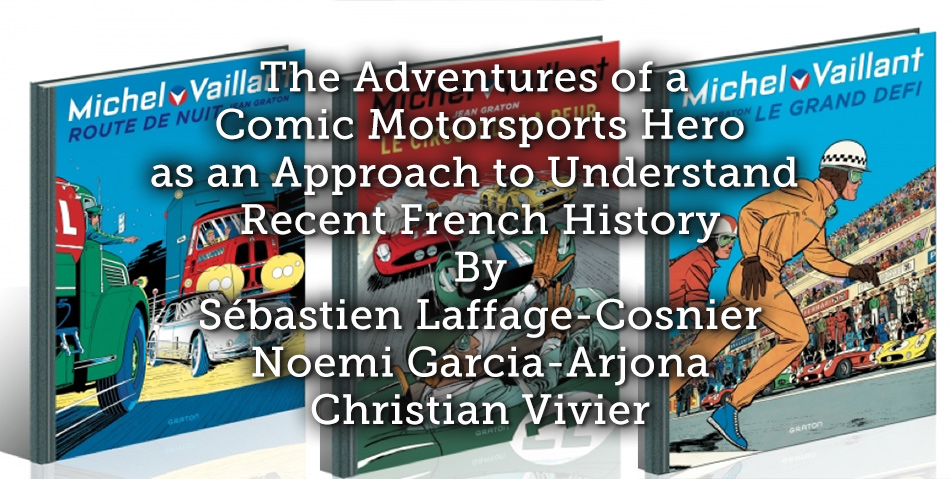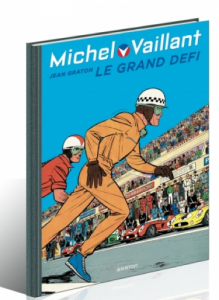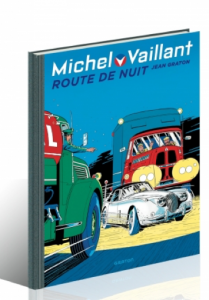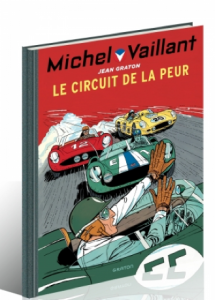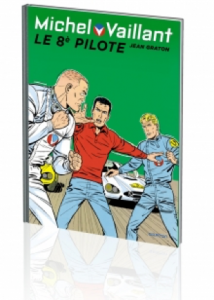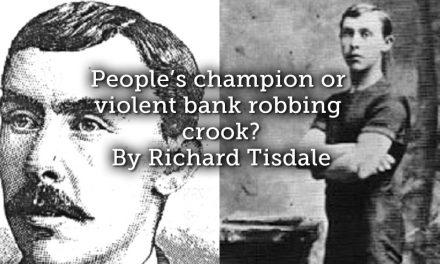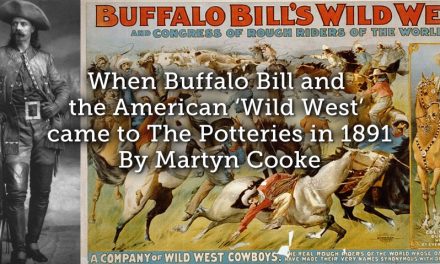This article has been contributed by the following authors:
Sébastien Laffage-Cosnier
Noemi Garcia-Arjona
Christian Vivier
“Culture, Sport, Health and Society” Research Laboratory
University of Franche-Comté (France)
The French comic motorsports driver Michel Vaillant, created by Jean Graton, first appeared in 1957 in the weekly Tintin. Young French boys that loved sports adventure and cars racing greeted this publication with great enthusiasm. We studied the first series of Michel Vaillant, composed of 16 comic books produced in the 1960s, from No. 1, The Great Challenge (1959), to No. 16, Km 357, released in 1969. This series has been translated into 15 languages and Michel Vaillant achieved an international reputation. Since the late 1950s, 71 albums and around 20 million copies have been sold.[1]
Michel Vaillant – Le Grand Defi (The Great Challenge) & Route de Nuit (Night Road)
Images from http://www.michelvaillant.com
By revisiting traditional approaches of analysis of sport history, our method is based on the sources analysis of the author’s inspiration, linking them to text bubbles, visual signs and iconic meanings of the comic drawings. We assume the notion of comic as dominantly visual literature.[2]We agree with Day and Vramplew’s recent article on revisiting methodologies employed for the history of sport and we accept that historical narratives have many different modes of expression. These expressions include the comic as a fictive or literary source, “given its power as a cultural force in shaping people’s understanding of their world”.[3]
Yet in the late 1950s and early 1960s, the comic did not get good press from the petty and middle bourgeoisie. If the stories could be drawn and presented to look like “real academic books”, they would gain immediate approval from parents. Jean Graton skilfully adapted his work to these demands. The text is a perfect fit and a pertinent indicator for making the comic book look educational. Graton did not, however, content himself with merely reproducing the enthusiasm of the period for car racing and for the French automobile. He went beyond the realm of sports and strove to educate his readers about motorsport and its economic challenges. This model prepared his youthful readers for the changes and modernity of the 1960s.
The Michel Vaillant comic book series preserved the traditional representations of the bourgeoisie. The first 16 albums faithfully portray the values and the social roots of upbringing of the 1960s, i.e., those of the importance of work and efficiency, family spirit, confidence in one’s closest friends, patriotism and the glory of the French flag. Nevertheless, the analysis of the comic book iconography based on the establishment of a mass culture dedicated to the automobile brings to light the existence of an urge to go beyond the limits of tradition. The idea of significant investment in cutting-edge research, innovation and reliability in order to compete internationally was broadly reflected in Michel Vaillant. Hence, the car races in which Michel Vaillant competed demonstrated the ruthless economic “battle” fought among the great nations and global companies during the second half of the twentieth century and the context of the Cold War.
Michel Vaillant – Le Circuit de la Peur (The Circuit of Fear) & Le 8e Pilote (The 8th Pilot)
Images from http://www.michelvaillant.com
Another important factor emerged in the sixties: the pop culture generation, seduced by massive industrial and commercial offers, responding to the desire for eternal life, youth and modernity. Media democratisation and the effects of a more visual society were also present in Michel Vaillant. The media were generally present throughout the series. This observation is not surprising given the spectacular nature of motorsport and the enthusiasm it provoked from the crowds.
In the end, the victories of Michel Vaillant made modernity visible and, by means of the car, a revered and symbolic object, brought young people, especially males, to the threshold of the world that was waiting for them when they left childhood and adolescence behind. The car hero embodies the young male population’s dreams of fast travel and intense experience. Our linguistic and iconic analysis of the 16 issues highlights the increase in speed capacity of motorized vehicles. While, from one album to another, car gears spin at ever-higher speeds, it would seem that, in no.16, the limits are reached. There were a number of myths that resonated and spoke to the readers of that time: the myth that mankind can hardly stop the steadily-perfected, fast, and powerful machines that he has made for decades and that they may end up harming him, and also that of the classic struggle between Ancient and Modern, between tradition and modernity. The success of Michel Vaillant became a modern myth, according to Roland Barthes’ analysis[4] – myths that reassured a generation who were concerned about their future and their participation in a liberal society driven by competitiveness, production and profit.
The conclusions of this research aim to explain the success of Michel Vaillant that reflects a detailed knowledge of the automobile sports industry, but also a reflection of modern myths like speed, youth and progress. This comic book is shown as shaping the domestic an international sports cars industry and a future in which young male people could be reflected.
Article © Noemi García-Arjona, Christian Vivier & Sébastien Laffage–Cosnier
[1] Sport.fr, ‘Lettre de l’économie du sport, n°675’, September, 18, 2003, http://www.sport.fr/automobile/michel-vaillant-un-tournage-au-coeur-des-24-heures-du-mans-31122.shtm (accessed October, 11, 2015).
[2] Thierry Groensteen, La bande dessinée: mode d’emploi (Bruxelles: Les Impressions Nouvelles, 2007), 133.
[3] Dave Day and Wray Vamplew, ‘Sports History Methodology: Old and New’, The International Journal of the History of Sport 32, no. 15 (2015): 1718.
[4] Roland Barthes, Mythologies (Paris: Seuil, 1954).

